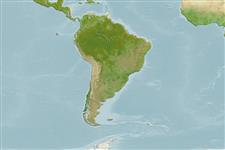Teleostei (teleosts) >
Anguilliformes (Eels and morays) >
Ophichthidae (Snake eels) > Myrophinae
Etymology: Myrophis: Greek, myros, -ou = male of morey eel + Greek, ophis = serpent (Ref. 45335).
More on authors: McCosker, Böhlke & Böhlke.
Environment: milieu / climate zone / depth range / distribution range
Ecology
Marine; demersal; depth range 0 - 1 m (Ref. 58018). Tropical
Western Central Atlantic: Colombia.
Size / Weight / Age
Maturity: Lm ? range ? - ? cm
Pale yellow to tan with tiny dark spots on snout, nape and body above lateral line. Dorsal fin origin only 1-2 pectoral fin lengths behind gill opening (Ref. 26938).
Life cycle and mating behavior
Maturities | Reproduction | Spawnings | Egg(s) | Fecundities | Larvae
Eschmeyer, W.N. (ed.), 1998. Catalog of fishes. Special Publication, California Academy of Sciences, San Francisco. 3 vols. 2905 p. (Ref. 26282)
IUCN Red List Status (Ref. 130435)
Threat to humans
Harmless
Human uses
Tools
Special reports
Download XML
Internet sources
Estimates based on models
Preferred temperature (Ref.
123201): 27.1 - 28.5, mean 27.8 °C (based on 115 cells).
Phylogenetic diversity index (Ref.
82804): PD
50 = 0.5078 [Uniqueness, from 0.5 = low to 2.0 = high].
Bayesian length-weight: a=0.00076 (0.00029 - 0.00199), b=3.06 (2.83 - 3.29), in cm total length, based on LWR estimates for this (Sub)family-body shape (Ref.
93245).
Trophic level (Ref.
69278): 4.1 ±0.7 se; based on size and trophs of closest relatives
Resilience (Ref.
120179): High, minimum population doubling time less than 15 months (Preliminary K or Fecundity.).
Fishing Vulnerability (Ref.
59153): Low to moderate vulnerability (28 of 100).
